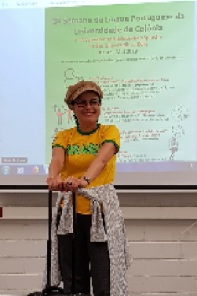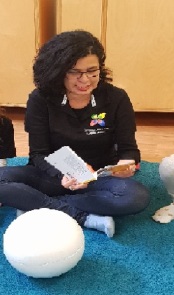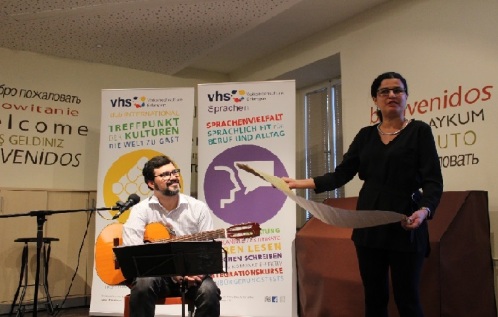| english |
| Home |
| Texto-Vivo project |
| Illustations |
| Books |
| Galerie 1 |
| Galerie 2 |
| Fotoalbum |
| Gästebuch |
| Kontaktformular |
 |
The project Texto-Vivo is an artistic geopoetic meeting point between global and local perceptions of Brazil and its cultures, as well about the lusophones and their symbolism. This creative intercultural experiment was devised and authored by Jamile do Carmo, a visual artist, writer and composer, and explores a perception of the world through the diversities of the Portuguese languages not only as they are spoken and written, but also incorporating direct or indirect language forms that are beyond the realm of words. Intercultural practices together with new concepts of territoriality are fostered, while seeking to strengthen Portuguese as a language of culture and science. It is divided into three parts:
1- Performance literária:
A performance literária trata-se de uma mescla entre expressão corporal e teatralidade na metaforização do "Eu literário". Numa relação direta com a nomenclatura Texto-Vivo, esta modalidade, de expressivo caráter crítico-reconstrutivo, consiste literalmente em vivenciar o texto; não lê-lo, mas atuá-lo, conferindo-lhe visualidade por uma interpretação através de ações que podem incluir dança, artes visuais e música. Uma encenação/ interpretação literária que, num jogo intertextual, busca ampliar o campo perceptivo do público jogando com seus repertórios. Impacto, estranhamento, releitura, dialogismo e reconstrução seriam os pontos fortes considerados nas performatizações literárias.
Literary performance is a mix between body expression and theatricality in the metaphorization of the "literary self". In a direct relationship with the Text-Vivo nomenclature, this modality, with an expressive critical-reconstructive character, literally consists of experiencing the text; not to read it, but to act it, giving it visuality through an interpretation through actions that can include dance, visual arts and music. A staging/literary interpretation that, in an intertextual game, seeks to expand the audience's perceptual field by playing with their repertoires. Impact, estrangement, re-reading, dialogism and reconstruction would be the strengths considered in literary performances.
2- Conta-ação:
Conta-ação é uma narrativa/interpretação de textos numa interação ativa com o público, utilizando objetos e/ou instalações como elementos de alusão simbólica aos temas explorados. Literalmente adentra-se na textualidade jogando com identidades e identificações. Na conta-ação conduzida em Texto-Vivo, estabelece-se uma dinamização na leitura dos textos buscando incluir o ouvinte/expectador num cenário geopoeticamente erigido pela territorialidade da linguagem, contrapondo o "eu e o outro", bem como o "lá e o cá". Muitas vezes similar à performance literária, a diferença é que, neste caso, o Eu literário não é explícito, trabalhando-se mais com narrativas dinâmicas a promover, dialeticamente, trocas de experiências reflexivas. Nas interseções entre histórias narradas e impressões pessoais, a ideia é criar inputs a um descondicionamento perceptivo diante do mundo envolvendo o público como co-autor, especialmente no que toca ao como a história pode/deve terminar e as razões para tal.
Conta-Ação is a narrative/interpretation of texts in an active interaction with the public, using objects and/or installations as elements of symbolic allusion to the themes explored. Literally enters the textuality playing with identities and identifications. In the action-account conducted in Texto-Vivo, a dynamism is established in the reading of texts, seeking to include the listener/spectator in a geopoetically constructed scenario by the territoriality of language, opposing the "I and the other", as well as the "there and the here". Often similar to literary performance, the difference is that, in this case, the literary Self is not explicit, working more with dynamic narratives to promote, dialectically, exchanges of reflective experiences. At the intersections between narrated stories and personal impressions, the idea is to create inputs to a perceptual deconditioning before the world involving the audience as co-author, especially with regard to how the story can/should end and the reasons for it.
3- Cancioneiro-Glocal:
No ano de 1516, o Cancioneiro Geral, de Garcia de Resende, assinala um importante período na língua portuguesa como a primeira obra impressa neste idioma. Reunindo inúmeros poemas e autores, é considerado um marco literário coincidindo com a época das grandes navegações e, assim, com a diáspora lusófona mundo afora. Baseando-se nesta poética de mobilidades, o "Cancioneiro Glocal" busca promover, numa perspectiva sincrônica/diacrônica, um paralelo simbólico a partir do intenso fenômeno diaspórico contemporâneo. Afinal, que territórios lusófonos se formam em outros espaços e quais suas ressonâncias? "Das caravelas que foram, agora são os aviões que vêm" - este é o jargão que ilustra este jogo de mobilidades poéticas. Cancioneiro Glocal, do neologismo entre global e local, visa criar e evidenciar uma plataforma musical-literária partindo da premissa de que todas as vozes cantam e contam, dando-lhes ressonância nos novos contextos móveis. Como o cancioneiro é originalmente um manuscrito, ao invés da música, geralmente utiliza-se aqui sons naturais que, como sinestesia, se reportam metaforicamente a territórios de forma atemporal: vento, água, folhagens, chuva, sons de animais etc. buscando, através dos textos/canções partilhados com o público, ressaltar o corpo como instrumento, o sujeito como ente participativo e a língua portuguesa como espaços de memória. É também um exercício de ouvir "os arredores". Acesso aos áudios em: https://poetajoao.com/ e no canal YouTube da editora GIRABRASIL.
The name Cancioneiro Glocal is a parody, inspired by the Cancioneiro Geral, of Garcia de Rezende (1470-1536), which in 1516 marked an important period in the Portuguese language as the first printed work in this tongue. At the beginning of the colonial era, sometimes referred to in European history as the height of the age of great navigations, Cancioneiro Glocal also marks the diffusion of the Portuguese language around the world. It creates a symbolic parallel to modern-day diasporas by encompassing all the positive and negative aspects of this idea in the globalized world. In the words of this work, “from the caravels and galleons that came, to the airplanes that now come”, it opens new images as a contrast to the colonial perspectives of new landscapes and territories to be conquered. “Glocal contacts” evokes spaces (there and here), times (past and present), memories, its subjects (the self and the other) and the writing of history symbolized by the feather-pen that merges with the images. Elements that intersect in words and forms, proposing, playfully, critical-reflective reinterpretations and reconstructions of meanings.The poetic-songs of Cancioneiro Glocal are performed with instruments as well as natural sounds of rain, wind, foliage, the sea, and more, in a kind of a metaphorical exercise of knowing how to listen to one’s current surroundings together with echoes of the past. Instrumentalized version are available at: https://poetajoao.com/ and on the YouTube channel of the publishing house GIRABRASIL.
PHOTOS:
Performance literária: A bagagem (The lugagge)
Conta-ação: O
Cancioneiro Glocal: Pedro, Pero & nós (with João Araújo)
 |  |
